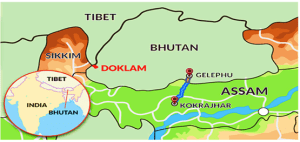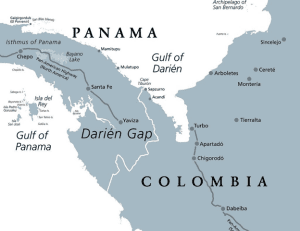THE CONTEXT: Recently, Bhutan’s King has unveiled the ‘Gelephu Smartcity Project,’ a mega international city near the Indian border covering 1,000 square kilometres. Bhutan’s plan for a regional economic hub at Gelephu, a town bordering Assam in India, are high on its agenda in the meeting in Delhi which is going to be held recently.
GELEPHU: THE MEGA PROJECT
- The plan was launched by Bhutan’s King Jigme Khesar Namgyel Wangchuck in December 2023 during the 116th National Day address at Changlimathang Stadium, Thimphu.
- It aims to build a “Gelephu Mindfulness City” (GMC) with a unique Bhutanese architectural blueprint across 1,000 square kilometres, as a special administrative zone with separate, investor-friendly laws.
- It is envisioned as an “economic corridor” connecting South Asia with Southeast Asia via India’s northeastern states to countries like Myanmar, Thailand, Cambodia, Laos, Vietnam, Malaysia, and Singapore.

SIGNIFICANCE:
- Employment and skilling: It aims to be an economic and social hub on Bhutan’s southern border, designed to benefit the entire South Asian region by providing local employment and skilling opportunities. It is likely to bring considerable benefits to Bhutan, necessitating key investments in public infrastructure such as roads, bridges, and airports, the primary goals of the initiative are to attract investments, boost trade and create jobs.
- Health and wellness hub: As a carbon-neutral city, Gelephu would include only non-polluting industries mainly IT, education, hotel and hospital sectors, and would be promoted as an investment destination and health and wellness hub in the middle of the region.
- Address youth migration: The growing “outmigration” of Bhutanese youth in search of jobs abroad is another challenge, and the government hopes a mega project such as Gelephu will address that. It aims to address economic challenges and reverse youth migration trends. The project is expected to generate economic opportunities for domestic Bhutanese as well as those in abroad. It is aimed at creating opportunities for the private sector and facilitating demand for goods and services.
- Foreign investment: The ambitious project would be a “Special Administrative Region” that would be governed under different laws to open the door for more foreign investment. The project will attract “quality investment” from “specially screened” international companies.
- Connectivity: The proposed land connection from Gelephu, traversing Assam and West Bengal, will over time reportedly give Bhutan access to Myanmar, Thailand, Cambodia, and Singapore. The project also includes building an international airport at Gelephu, the second such airport in Bhutan.
- Cultural influences: The plans for Gelephu involve developing it as a “mindfulness city”, “fostering conscious and sustainable businesses inspired by Bhutan’s Buddhist spiritual heritage and unique identity”.
- In sync with India’s projects: It would also lie at the crossroads of India’s “Act East” plans for connectivity to Myanmar, and on to Association of Southeast Asian Nations and the Indo-Pacific region as well as the new India-Japan connectivity plans between India’s north-eastern States through Bangladesh to the Bay of Bengal and Indian Ocean.
- Stable border: Gelephu offers Bhutan a way to open itself up in a controlled manner to the rest of the world, while also continuing negotiations with Beijing for a stable border.
ISSUES:
- Economic constraints: The Gelephu project is facing economic challenges as there is lack of investment and finances available to the project.
- Geographical issues: With warmer temperatures than in the mountains, Gelephu gets high amounts of rainfall during a monsoon season that lasts several months, leading to considerable flooding each year. Also, the surrounding forests and wildlife populations place Gelephu right in the middle of elephant corridors.
- Chinese concern: Countering China is Bhutan’s most pressing geopolitical concern. Bhutan faces pressure from China to conclude a boundary resolution deal and to establish diplomatic ties.
- Insurgencies in Assam: Insurgencies in Assam and the northeastern States and just across the Indian border in Myanmar have been an area of great concern in the past leading to a major military operation (Operation All Clear) by Bhutan in 2003.
- Landlocked: As Gelephu is landlocked, it is dependent on other countries, primarily India, to provide the infrastructure for trade and transport out of the special administrative region.
THE WAY FORWARD:
- Support from India: The Gelephu project will require a major support from India. For example, the first part of the Gelephu project involves scaling up the Gelephu airport and tarmac to international standards, which will need financing and expertise from India.
- Scale up tourism: Apart from hydropower, tourism is Bhutan’s strength, but the kingdom has always discouraged mass tourism, preferring instead a “high value, low volume” motto to ensure sustainability. However, to increase the revenues, Bhutan must scale up its capacity to take in more tourists and visitors.
- Countering China: Both Bhutan and India need to cooperate together to counter Chinese influence in the project. There should be no repeat of missing opportunity as of Sri Lanka’s Hambantota a decade ago, which caused unsustainable debt.
- Strengthening relationship: India and Bhutan have built a strong relationship, based on a understanding between every Bhutan’s king and Indian Prime Minister over the past 75 years. There is a need to continue the goodwill generated by India’s generous support.
- Future project: The conditions for a mega-smart city with no immediate returns from the investment envisioned for the GMC, are not optimal at present. However, as the global setting grows more polarised and countries increasingly opt for foreign policies that draw more from traditional allies in their respective neighbourhoods, India too must find its wlly in the region that shares language, faith, culture, geography and climate.
THE CONCLUSION:
The Gelephu project is a huge gamble for Bhutan but can be a gamechanger for the region, with the support from India. The mega project offers a chance for the region to create opportunities and build connectivity in the region.
UPSC PREVIOUS YEAR QUESTIONS
Q.1 Increasing interest of India in Africa has its pros and cons. Critically examine. (2015)
Q.2 Discuss the political developments in the Maldives in the last two years. Should they be of any cause of concern to India? (2013)
MAINS PRACTICE QUESTION
Q.1 Analyse the significance of recently proposed Bhutan’s Gelephu project. Discuss the issues faced by the project and India’s role to address the challenges to ensure connectivity in the region.
SOURCE: https://www.thehindu.com/opinion/op-ed/bhutans-opening-move-its-gelephu-gambit/article67951801.ece#:~:text=The%20plan%2C%20launched%20by%20Bhutan’s,separate%2C%20investor%2Dfriendly%20laws.


